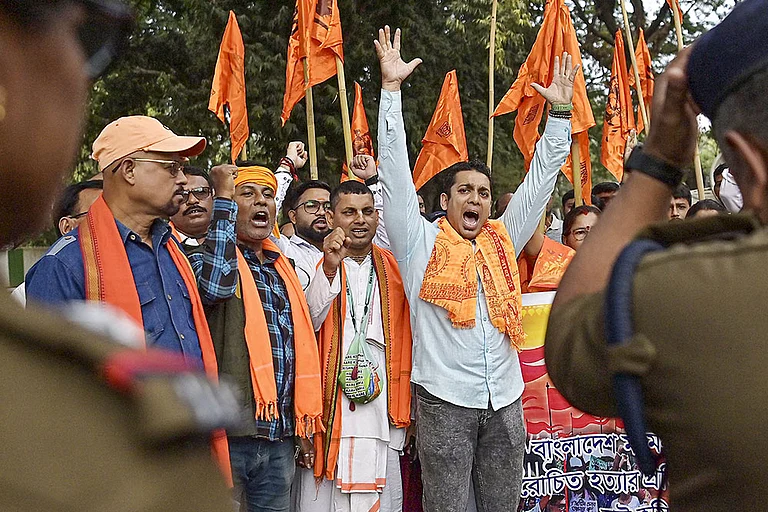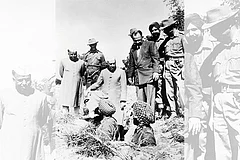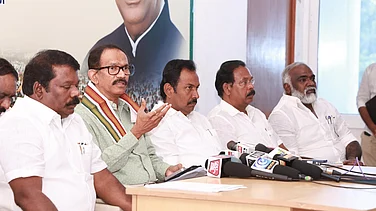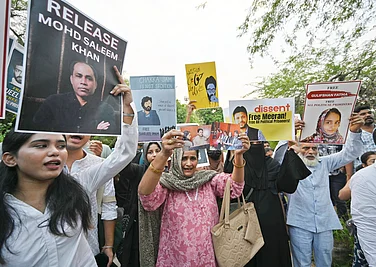On the misty morning of February 21, the protesting farmers were gathered at the Shambhu and Khanauri borders, waiting for the skies to clear and preparing to break through the barricades to march to Delhi. Among them was Shubhkaran Singh, 22, a contractual farmer from Bathinda. He went to an elderly farmer and asked for a glass of water. “Jiththe marange, uththe jitange (I will fight till my last breath),” Singh told the farmer. These were his last words.
A few hours later, Singh was allegedly shot at the back of his head and died on the spot after clashes between police forces and farmers turned violent at Khanauri. Singh’s friend called up his family, which lives in Baloh village in Bathinda, about 100 kms from the border, and broke the news to them.
The family is yet to come to terms with the sudden loss. A visit to Singh’s home, located at the farthest corner of large swathes of fields, debunks the narrative that the protesting farmers are wealthy. There are those like Singh as well. The house is old. The paint is peeling; there are cracks in the walls. A poster bearing Singh’s photo hangs from the outside wall. His childhood friend is staring at the picture. Sitting in the main room are Singh’s younger sister, his father, who suffers from a mental illness, his grand-aunt and the newest addition to his family—Jimmy, the pet dog. His mother left the house when he was two and he was brought up by his paternal grandparents and then his grand-aunt.

The grand-aunt sits outside Singh’s room, inconsolable, looking at her grandson’s most valuable possession—a seed drill machine painted in green and yellow. Singh was possessive about his tractor that is now parked in the neighbourhood yard. A black flag tied to the smokestack was his way of protesting against the government.
Singh was an unfortunate victim, says his family. There could have been more because the day he died in Khanauri, clashes turned violent at Shambhu border, too. When the protesting farmers were running helter-skelter to escape the tear gas shells fired at them, drones followed them, dropping more shells. But the farmers were prepared. They had excavators and JCB bulldozers with modified cabins, anti-riot shields and gas masks to counter the tear gas shells and pellets fired at them. A fully-geared farmer said: “Once we get the green signal, we will take down the barricade in 10 minutes.” Dozens of sandbags were kept ready to construct makeshift paths to cross the interstate border. But the farmer leaders asked them to be patient.
A day before, on February 20, farmers rejected the Centre’s proposal of a five-year contract to buy pulses, maize, and cotton at minimum support price. Following this development, the farmers vowed to go ahead with their ‘Delhi Chalo’ march. “We deserve a blanket legal guarantee of MSP. We have been fighting for these demands for so long. We won’t back down now,” said Kartar Singh, 60. He hails from a village at the far end of Firozpur from where the India-Pakistan border can be seen.
“It’s unfortunate the way the police are treating us here. The security forces at the country’s border sometimes share food and exchange a few words with those posted on the other side, but here, they are so brutal. We are citizens of this country and we are the food providers. Is this how they should treat us,” he asked.

According to Punjab’s health department, 177 people have been injured in the farmer protests at Shambhu and Khanauri so far. The actual number could be higher, say farmers. More than 200 people have been injured in Shambhu alone, as per the information gathered from the ground, while another 200 are said to have been injured at Khanauri. Three farmers have died in the protests and as per the Haryana Police at least 12 police personnel have sustained injuries.
A few hundred metres away from the clashes, the other farmers still waited for instructions from their leaders. The overall peace was disrupted occasionally by the tear gas shells bursting down the road. “Why are these kids racing to the barricades?” an elderly farmer asked his friend. “Our leaders have asked us to wait until their negotiations are complete. But these youngsters are full of rage. They must have patience,” he said.
***
Despite the clashes, the protesters have stayed put. Makeshift kitchens have been set up between the queues of tractor-trolleys parked on both sides of the National Highway-1 where the farmers have set up langar (community kitchens). Food is provided not only to the protestors but also to the underprivileged people living close by.
“We prepare langar every morning to serve everyone without discriminating against anyone,” says Bhupinder Singh, 54, from Gadapur village. “On a daily basis, we make six to seven handis (pots) of rice, along with chai, and on some days, kheer. Women in the nearby villages start their day early and make rotis.”
This time, the women are largely missing from the Shambhu border, yet they are making their presence felt. About three kms away from the site, at a gurudwara, 10-15 women gather every day as early as 5 AM to prepare langar. A majority of the langar served at the protest sites comes from the nearby villages. They relentlessly prepare food for 10 to 12 hours. “We do whatever we can from here to help our brothers and children who are sitting at the Shambhu border,” says Surinder Kaur, one of the women preparing langar.
Compared to 2020-21, fewer women have joined the protests this time. When asked the reason, a farmer leader said: “Women from our family are not into farming. They take care of our homes and families.” This is the story of many women farmers in India. According to an Oxfam India report, although about 85 per cent of rural women are involved in agricultural activities, only about 13 per cent of them own land. Most of them are not even recognised as farmers.

Sheltered away under the tarpaulin-covered tractors, a small group of women sit steadfast in their support for the farmers at Shambhu. They have been camping at the site since February 11 and remain determined to continue to fight against all odds. “As women, there are challenges of living under open sky for days. Getting privacy is a challenge,” says Manjeet Kaur, 48.
While the men at the protest turn barrels into geysers for hot water and take baths on the streets, women have to travel long distances to find a secluded space to bathe. “But we have come here leaving our families and children at home to protest. We will stay here and keep fighting just like last time,” she adds.
Sitting on a chatai (mat) in front of a red tractor, Gurudev Singh (74) and Bhajan Singh (70) spend their afternoon reading bits and pieces from newspapers to know more about their protests. With the internet shutdown at the Shambhu border, the two childhood friends bank on these newspapers brought to them by journalists and other people from the cities. They read out: ‘Andolan ke dagar par kisan’ (the agitating farmers). An op-ed piece in a Hindi daily leads them to open up about the declining income of farmers for the past two decades.
“If we look at the current situation of farmers, everything seems to be taken on loan—including these tractors you see. Half the income we earn goes into repaying loans,” says Gurudev Singh. His friend, Bhajan Singh, adds: “It’s not only the government’s unpredictable policies and false promises but also the unpredictable weather conditions that have added to our woes.”
The other farmers sitting there said that they are struggling to get fair prices for other crops like moong, mustard, masur, sunflower despite an MSP. “Although the government has declared minimum support prices for a few of these crops, they do not buy at these prices,” says Gurudev Singh.
Farmers allege that there’s a lack of employment for the youth of Punjab. “They are either forced to go abroad or take up farming unwillingly. The rest do odd jobs like driving,” says Kaka Singh, 60, who sighs at what his grandson, who recently moved to Canada, told him: “Iha tuhadi samasi’a hai (This is your problem).”
Singh, who hails from Dakaunda village in Patiala, believes that the recent government policies have only been consumer-centric and not farmer-centric.
Responding to the government’s unwillingness to guarantee MSP, he says: “MSP will not benefit the big players hence the government does not want it. Farmers have been long used as a tool to control inflation in the country but no one bothers to know what the farmers are actually going through.”
MORE FROM THIS ISSUE
In all likelihood, Shubhkaran Singh and his family will be forgotten in a few months, say farmers. The young protester leaves behind a 20-year-old sister, who is yet to complete her education and a loan that has to be repaid. To pay tribute to Singh, his uncle, aunt, father and sisters are now sitting in protest at the Khanauri border. “He was one hard-working lad who always fought for the rights of farmers. He was a part of the 2020-21 protests, too. Who knew this would be his last,” says his uncle Charanjit Singh.
(This appeared in the print as 'Voices From The Ground')
































